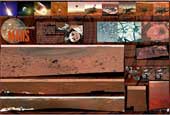
 |
|
|
|
This book first appeared in 2007 under the title of The History of Astronomy. Although this new edition is not presented in the same format, I am pleased it has retained its bright and breezy quality. The foreword is written by the late Sir Arthur C Clarke in which he talks of early notions of space travel as mere science fiction, coupled with anecdotes on rockets and the arrival of the space age in 1957. Clarke’s foreword also mentions how he assisted in bringing potentially the first analogue computer, the Antikythera Mechanism, to the world’s attention – a computer that displays the positions of the Sun and Moon on any given date. The book is the authors’ own entertaining travelogue that takes us from early civilisations through to the new Kepler satellite now orbiting the Earth. I particularly enjoy the inclusion of a variety of interviews – all interviewees being authorities in their respective fields. The first chapter deals smartly with a cultural and spiritual overview that details elements that were so important. This story is always astronomically referenced where necessary. The finding of the Antikythera Mechanism in October 1900 is recalled in chapter three along with a fascinating interpretation by world-leading astronomical historian Dr Allan Chapman of Oxford University. The subtitle of this book is How the Universe Revealed its Secrets and this is very apparent in the important discussions on Nicolaus Copernicus, Tycho Brahe and Johannes Kepler. Copernicus’ opus, posthumously published in 1543 that clarifies his theory that the Earth revolved around a centrally placed Sun, is without doubt a keystone in the story of astronomy. It’s a turning point that opened up the floor for what became centuries of debate on stellar evolution, the distances and arrangements of stars, much of which is now revealing itself with new planets being found orbiting stars. The invention of the telescope is quickly anointed to Hans Lipperhey, thus removing the Galileo myth. Halley, Newton and Herschel are all contained amongst others. The book also importantly covers the birth of radio astronomy that leads us into today’s cosmology. Astronomy has no boundaries and thankfully neither does this book. The pace moves swiftly and links together well serving as an excellent signpost for further research. Ian Welland |
|
|
|
2009 Yearbook This 132-page special edition features the ultimate observing guide for 2009, a review of all the biggest news stories of 2008, in depth articles covering all aspects of astronomy and space missions for 2009, previews of International Year of Astronomy events and much, much more. This 132-page special edition features the ultimate observing guide for 2009, a review of all the biggest news stories of 2008, in depth articles covering all aspects of astronomy and space missions for 2009, previews of International Year of Astronomy events and much, much more.Infinity Rising  This special publication features the photography of British astro-imager Nik Szymanek and covers a range of photographic methods from basic to advanced. Beautiful pictures of the night sky can be obtained with a simple camera and tripod before tackling more difficult projects, such as guided astrophotography through the telescope and CCD imaging. This special publication features the photography of British astro-imager Nik Szymanek and covers a range of photographic methods from basic to advanced. Beautiful pictures of the night sky can be obtained with a simple camera and tripod before tackling more difficult projects, such as guided astrophotography through the telescope and CCD imaging.Exploring Mars  Astronomy Now is pleased to announce the publication of Exploring Mars. The very best images of Mars taken by orbiting spacecraft and NASA's Spirit and Opportunity rovers fill up the 98 glossy pages of this special edition! Astronomy Now is pleased to announce the publication of Exploring Mars. The very best images of Mars taken by orbiting spacecraft and NASA's Spirit and Opportunity rovers fill up the 98 glossy pages of this special edition!Mars rover poster  This new poster features some of the best pictures from NASA's amazing Mars Exploration Rovers Spirit and Opportunity. This new poster features some of the best pictures from NASA's amazing Mars Exploration Rovers Spirit and Opportunity. |
||||||||||||||||||||||||